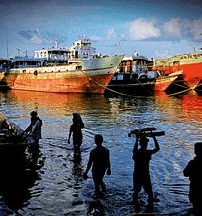UPSC Exam > UPSC Notes > Indian Society for UPSC CSE > Modern Slavery and Global Slavery Index
Modern Slavery and Global Slavery Index | Indian Society for UPSC CSE PDF Download
Modern slavery involves one person possessing or controlling another person in such as a way as to significantly deprive that person of their individual liberty, with the intention of exploiting that person through their use, management, profit, transfer or disposal. Modern slavery contributes to the production of at least 122 goods from 58 countries worldwide. The International Labour Organization (ILO) estimates the illicit profits of forced labour to be $150 billion a year.
Global Slavery Index (GSI)
Global Slavery Index (GSI) is published by the Walk Free Foundation, a global human rights organization with a mission to end modern slavery in a generation. The report looks at prevalence (the percentage of a country’s population that is enslaved) as well as the total number of people living in modern slavery in each country.
Global Slavery Index (GSI) 2014
- Modern slavery exists in all 167 countries.
- Globally, 35.8 million people are enslaved across the world.
- Five countries accounts for 61% of the world’s population living in modern slavery.
- 23.5 million people are in Asia, two-thirds of global total in 2014 (65.8%).
- India and Pakistan alone account for over 45% of total global enslaved population.
- Mauritania has the highest proportion (prevalence) of its population in modern slavery, at 4%, followed by Uzbekistan (3.97%), Haiti (2.3%), Qatar (1.36%) and India (1.14%).
- India is on top of the list (absolute numbers) with about 14.29 million enslaved people, followed by China with 3.24 million, Pakistan 2.06 million, Uzbekistan 1.2 million, and Russia 1.05 million.

Global Slavery Report 2014 : Findings on India
- Particularly in countries such as India and Pakistan, nationals – often including entire families – are enslaved through bonded labour in construction, agriculture, brick making, garment factories and manufacturing.
- India’s modern slavery challenges are immense. Across India’s population of over 1.2 billion people, all forms of modern slavery, including inter-generational bonded labour, trafficking for sexual exploitation and forced marriage, exist. Evidence suggests that members of lower castes and tribes, religious minorities and migrant workers are disproportionately affected by modern slavery. Modern slavery occurs in brick kilns, carpet weaving, embroidery and other textile manufacturing, forced prostitution, agriculture, domestic servitude, mining, and organised begging rings. labour is particularly prevalent throughout India with families enslaved for generations.
- There are reports of women and children from India being recruited with promises of non-existent jobs and later sold for sexual exploitation, or forced into sham marriages. In some religious groups, pre-pubescent girls are sold for sexual servitude in temples. Recent reports suggest that one child goes missing every eight minutes; it is feared that some are sold into forced begging, domestic work, and commercial sexual exploitation.
- On paper, criminal justice reforms specific to human trafficking are the strongest component of India’s response to modern slavery. In 2013, the government amended the Indian Penal code to include specific anti-trafficking provisions. In 2014, the government expanded the number of police anti-human trafficking units across the country to 215 units, aiming to establish a unit in 650 districts.
- The judiciary and over 20,000 law enforcement have received training on victim identification, the new legal framework, and victim-centered investigations.
- Dalits have the least social protections and are highly vulnerable to severe forms of exploitation and modern slavery. Approximately 90 percent of India’s labourers are in the informal economy.
The document Modern Slavery and Global Slavery Index | Indian Society for UPSC CSE is a part of the UPSC Course Indian Society for UPSC CSE.
All you need of UPSC at this link: UPSC
|
21 videos|125 docs
|
Related Searches





















